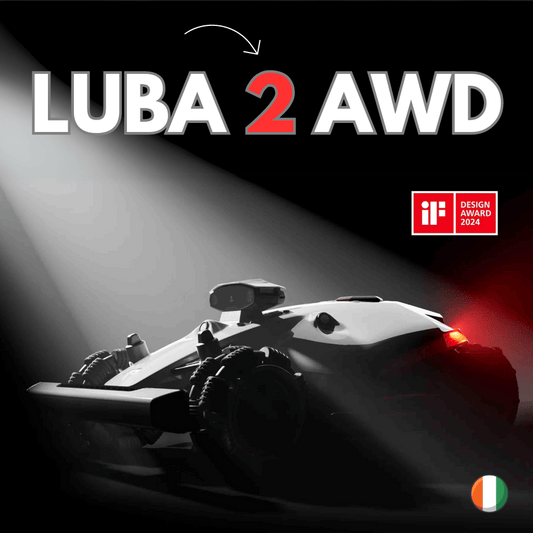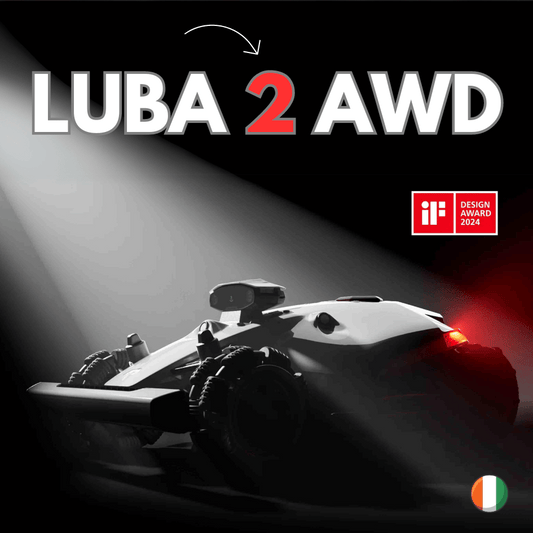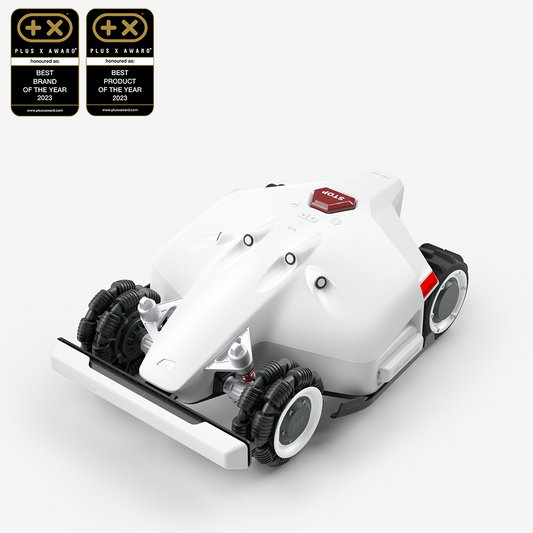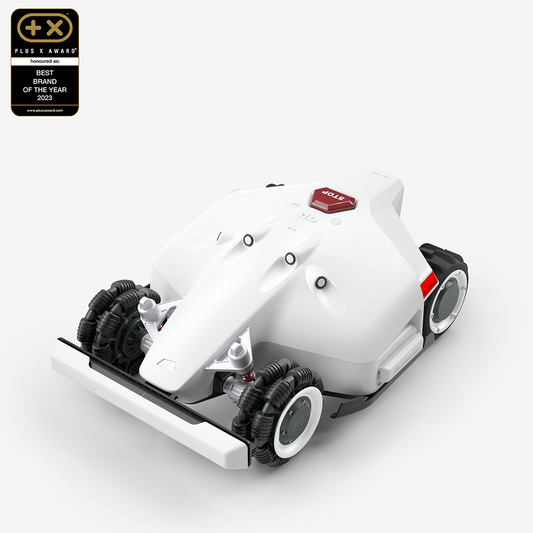Following the initial excitement around the Luba mower last year, designed specifically for large lawns with challenging terrain, I'm thrilled to present our latest offering: the Luba 2.
Addressing feedback from our loyal customer base, Mammotion's latest iteration introduces significant advancements, including improved navigation around trees and other garden features.
With a year of learning and systems implementation behind us, customer support and market readiness have seen vast improvements.
I'm Barry at Mowers.ie, and today we'll explore how the Luba 2 stacks up against its predecessor.
While the Luba 1 set a high benchmark in robotic lawn care, the Luba 2 strives to push the envelope further.
Key to this year's model are the enhanced cutting options across a broadened model range and improvements in both design and function, providing tailored solutions for varying lawn needs.
In addition, the Luba 2 boasts an innovative vision module intended to refine obstacle avoidance—a game-changer in the realm of autonomous lawn care.
I'm eager to dive into the nuances of these models, evaluating their performance, and helping you determine which mower might be the best choice for your garden's specific conditions.

Key Takeaways
- The Luba 2 expands on the foundation laid by the Luba 1 with customer-informed improvements and a wider range of cutting options for different lawn needs.
- Design enhancements and the introduction of a vision module in the Luba 2 aim to address obstacle avoidance and navigation, offering a smarter and more efficient mowing experience.
- Enhanced connectivity features, including an optional 4G module, provide increased operation convenience and security for the Luba 2, catering to diverse user needs.
Insight on Luba 1 and Upgraded Luba 2 Models
In the previous year, my introduction of the Luba was centred on enhancing the wireless all-wheel robotic mower specifically for expansive lawns, uneven landscapes, and sharp gradients. This season, I'm extending our tech to cater to arbor care.
While the initial Luba range navigates less smoothly around obstacles, the newest member of the family, Luba 2, brings promising solutions.
When examining the two models, one can identify numerous similarities but also key enhancements based on user feedback.
I've learnt much since first entering the market, especially about providing robust support, which has significantly improved for the new product stage.
Testing for Luba 2 has been quite limited; however, trials in Florida have offered promising insights.
Despite this, it's worth noting that Luba 2 isn't quite ready for general release, as it’s still being refined.
Once fully market-ready, I anticipate enjoying the investigative process, pitting the two models against each other to gauge the Vision system's effectiveness.

Here's a quick rundown of the Luba range:
-
Luba 1 line-up was classified into three sizes:
- 1/4 acre
- 3/4 acre
- 1 acre and a quarter
-
Luba 2 has expanded this range with four sizes:
- 1/4 acre
- 3/4 acre
- 1 acre
- 1 acre and a quarter
- 2 and 1/2 acres
Plus, each size is available in two variants - one for low and another for high grass cuttings targeting varying geographic lawn types.
The interface largely remains unchanged; however, modifications to improve durability against moisture have been introduced, including an optional cover for Luba 1 owners. Other enhancements on the Luba 2 model include:
- Omnidirectional front tyres
- Paddle-style rear wheels for improved traction on diverse terrains
- A refined cutting system with reduced blade guard to mitigate grass build-up
Performance-wise, the incline capabilities have also seen an improvement:
- Luba 1: Handles up to a 75% gradient
- Luba 2: Capable of tackling an 80% gradient
One significant upgrade is the Vision module that augments the already present ultrasonic sensors - with Luba 1 possessing four and Luba 2, three, accompanied by the new Vision technology.
This enhancement enables smarter obstacle navigation and allows the device to serve as a surveillance tool, offering peace of mind when I'm away.
Both models maintain their RTK and wireless attributes. Still, Luba 2 adds an extra layer of robustness with its Vision system to improve signal redundancy, reducing connectivity issues significantly.
As for connectivity options:
- Luba 1: Supports Bluetooth and Wi-Fi
- Luba 2: Offers Bluetooth, Wi-Fi, and an optional 4G connection for superior operation and security
Market Engagement and Consumer Assistance
Early Obstacles in the Launch Phase
I encountered quite a few hurdles when introducing the original Luba to the market. It was particularly aimed at extensive lawns with uneven landscapes and sharp inclines. Adapting to these challenges was essential, especially as obstructions like trees made it difficult for the mowers to navigate efficiently.
Advancements in Product and Market
Over time, the product has evolved to meet more varied customer requirements, with Luba 2 now offering models that cater to larger properties up to two and a half acres.
Furthermore, we've introduced both high and low cut versions of each model, addressing the diverse grass lengths found in different regions.
Essential improvements have also been made to the mower’s design and functionality, from omnidirectional front tyres to a more efficient cutting system. These refinements have been very well-received.

Evaluation of Luba 2 Trials
Restricted Examination Scope
My assessment of the Luba 2 thus far has been somewhat limited, particularly focusing on testing within Florida.
David, my dedicated support manager, has been instrumental in gathering early-stage data and has undertaken extensive trials.
Despite this activity, I cannot assure that Luba 2 is ready to be released as a finalised product for the market.
It currently remains within its refinement phase and isn't packaged for customer delivery.
My stance is that revealing this stage of product development wouldn't be an accurate representation since the Luba 2 is still maturing through its trial phase.
Prospects of Extensive Testing
In terms of future test plans for Luba 2, comparisons between the current and previous models will be enlightening, focusing on the advanced vision technology as a key differentiator.
I'm eager to see how this interacts with other wireless solutions in practical terms.
Furthermore, comprehensive insights will be gained into the enhanced traction of the new rear wheels on various terrains and the anticipated improved cut quality due to the adjusted blade guard design.
Model Lineup: The Luba 2 offers both high and low cut versions across four different model sizes, catering to lawns up to two and a half acres, which demonstrates a response to diverse customer requirements observed from the previous year.
Innovations:
- Vision Module: Provides a more nuanced approach to obstacle detection compared to last year's ultrasound-based system.
- Handling Grades: Increased capability from a 75% to an 80% gradient signifies an improvement in handling challenging terrains.
- Connectivity Options: Inclusion of an optional 4G connection on top of Bluetooth and Wi-Fi, enhancing operational and security features.
Refinements:
- Wheel Design: The use of omnidirectional front tyres and paddle-style rear wheels anticipates better performance across different ground types.
- Button Seals: Introducing a tighter seal around power and stop buttons to reduce moisture infiltration.
Surveillance Feature: The vision system allows remote viewing, emulating a security device's functionality while mowing—a novel feature, though the practical uptake remains to be evaluated.
Continued collaboration with the makers of Luba is essential and I remain hopeful for what the future holds for both product support and continued technological advancements.
Comparative Overview of Model Ranges
Spectrum of Model Variants
Last season, I embraced the challenge of larger lawns with uneven terrain and steep inclines with the launch of my wireless, all-wheel-drive robotic mower. This year, I've extended my focus to include an even more diverse landscape.
I now offer four model variants catered to different sizes of lawns: four are suitable for 1/4 acre, 3/4 acre, 1 acre, and an extensive 2 1/2 acres.
These options are designed to accommodate a range of consumer needs, effectively bridging the gap between small, manageable plots and larger, more demanding spaces.

Variants for Different Grass Heights
Recognising the variance in grass types and lawn preferences across regions, I've introduced both high and low cut versions for each model.
This means that, whether you're in the southern regions where shorter grass is preferable, or in the north with lusher, taller grass, there's a mower that fits.
Key Specifications and Features:
- Cutting Ability: Cutting system remains constant with two durable blades, and I've minimised the blade guard to lessen grass clumping.
- Traction: I've upgraded to omnidirectional front tyres and paddle-style rear wheels, enhancing movement on wet or sandy terrain.
- Gradient Handling: I can tackle up to an 80% gradient, showing improvement over last year's 75%, hence increasing adaptability to steep slopes.
- Navigation and Obstacle Avoidance: With my state-of-the-art vision module, I can now deftly navigate obstacles, which complements my existing ultrasonic sensors. This system not only enhances lawn navigation but offers remote surveillance capabilities.
- Connectivity and Security: Progressing from Bluetooth and Wi-Fi, now there's an optional 4G connectivity for robust operation and improved security features, allowing for remote monitoring and increased operational reliability.
Table of Features Across Models:
| Model Variant | Lawn Size | Grass Height Option | Slope Handling | Vision Module | Connectivity Options |
|---|---|---|---|---|---|
| Model 1000 | 1/4 acre | High & Low | 80% | Yes | Bluetooth, Wi-Fi, Optional 4G |
| Model 3000 | 3/4 acre | High & Low | 80% | Yes | Bluetooth, Wi-Fi, Optional 4G |
| Model 5000 | 1.25 acre | High & Low | 80% | Yes | Bluetooth, Wi-Fi, Optional 4G |
| Model 10000 | 2 1/2 acres | High & Low | 80% | Yes | Bluetooth, Wi-Fi, Optional 4G |
Design Similarities and Upgrades
Consistent User Experience
In observing the developments from the initial iteration, it is evident that there is a strong emphasis on maintaining a cohesive user experience.
The user interface retains its familiar layout, ensuring that existing users will not encounter a steep learning curve.
Adjustments have been made in response to user feedback, which has led to the integration of soft-touch buttons and more robust seals to enhance the product's tactile and functional aspects.
- Improved power and stop button design for better interaction
- Retention of the intuitive interface for ease of use
Enhanced Water Resistance Measures
In addressing the concerns of moisture accumulation, the second edition of the robotic mower has taken a significant step forward.
A cover has been introduced to mitigate the issue of water pooling in crevices, which was an occasional occurrence in the previous model.
This cover is also available for current owners of the original mower.
- Introduction of a cover to prevent moisture accumulation
- Continuation of the rain sensor with enhancement for water detection
Refinements in moisture protection:
- Tighter seal around power and stop buttons to minimise water ingress
- The rain sensor persists with design improvements for efficacy
| Feature | Improvement |
|---|---|
| Power and Stop Buttons | Enhanced seal to prevent water entry |
| Rain Sensor | Continues with added sensitivity |
Additionally, this initiative has laid the groundwork for better protective measures against the elements, ensuring sustained operational efficiency irrespective of weather conditions. It reflects my commitment to refining the product based on the practical usage and feedback from the first year on the market.
Design Evolution and Enhancements
All-Angle Front Tyres
- Multidirectional Capability: Front tyres redesigned to rotate in all directions, replacing previous all-wheel drive treads.
Enhanced Back Wheels
- Paddle-Style Traction: The rear wheels now feature a paddle design, improving grip on various surfaces including damp grass and sandy soils.
Streamlined Safety Shield
- Optimised Blade Protection: Reduced guard size to mitigate grass clumping, while maintaining safety and improving mowing performance.
Inclination Performance Improvement
- Slope Mastery: Enhanced capability to tackle steeper gradients, rising from a 75% to an 80% incline threshold.

Vision Module Integration
- Obstacle Navigation: A brand new visual system aids in recognising and circumventing hindrances, offering smarter, more adaptive behaviour.
- Remote Surveillance: Access to the mower's visual feed while away, analogous to a roaming security camera.
- Signal Redundancy: Combines visual data with RTK navigation to maintain operational integrity, even with signal disruptions.
Navigating Challenges and Enhanced Visual Capabilities
In my experience with robotic lawnmowers, addressing the issue of obstacles and refining navigation systems has been pivotal.
The past year taught me a great deal - from customer feedback to product performance in various environments.
It's been an insightful process collaborating with companies such as MIM Motion. Establishing robust support systems has substantially improved the readiness of products like the 'Luba 2' for the market.
Having tested the latest models, I noted key developments, particularly in how the newer versions manoeuvre around potential obstructions.
I can assert that the Luba 2 exhibits significant progression in its avoidance capabilities compared to its predecessor.
The introduction of a vision module sets the newest model apart; this advanced feature acts as a cornerstone for smarter navigation amongst a myriad of garden features and topographies.
The previous model had an admirable obstacle detection system, but the Luba 2 refines this with both ultrasonic sensors and the newly incorporated Vision System.
This hybridised approach mitigates navigation errors seen in RTK systems when GPS reception becomes unreliable due to overhead obstructions like trees.
Consequently, the Luba 2 can discern its surroundings more effectively and continue functioning with minimal interference, resulting in greater efficiency over its predecessor.
The Vision System is more than a navigational aid. It also provides a form of surveillance—a watchful eye over your lawn while you're absent.
This aspect could be seen as a modern embodiment of the 'Ring doorbell' concept, now innovatively integrated into mobile outdoor machinery.
It’s an optional feature, but it could serve as a reassurance for users desiring an additional layer of security or peace of mind.
Now, onto the physical aspects.
Switching to omnidirectional front tyres was a judicious choice.
This, in tandem with the newly designed rear paddle wheels, furnishes the Luba 2 with enhanced traction—a notable benefit when the terrain beneath is slippery or sandy.

Another strategic alteration is the reduced blade guard; this prevents grass clippings from accumulating and interfering with the functionality, subtly improving overall performance.
Significantly, the Luba 2 tackles steeper inclines—an 80% gradient—outstripping the earlier model's 75% capacity.
Model options have expanded as well, with offerings that cater to various lawn sizes, including a sizeable jump to cover 2 and 1/2 acres.
With both high and low cut versions, the needs of customers from different regions, with diverse grass lengths, are accommodated.
Connectivity has been a key focus too; while Luba 1 offered standard Bluetooth and Wi-Fi, Luba 2 includes these along with an optional 4G connection.
This enhancement not only simplifies operations but also fortifies the security of the system.
Users now have more flexibility in remote monitoring which complements the built-in GPS and aids in theft prevention.
This all-round improvement confirms my belief in the product; it's crafted to meet users' evolving needs.
The revised interface elements like the stop and power buttons illustrate the attention to detail and user experience.
They now come with an improved seal, reducing the propensity to retain moisture and ensuring greater product longevity.
Such refinements are the fruits of my learned experiences and highlight the value of continuous improvement in outdoor robotics.
Interaction Between RTK and Visual Recognition in Robotic Mowers
Last year's introduction of a revolutionary wireless four-wheel-drive robotic mower marked a significant leap in the realm of large lawn maintenance. This technology was especially proficient on complex terrains and steep gradients.
This year, it's not just about the lawn; the focus has shifted to the trees.
The RTK mowers from the previous season had their challenges with navigating around obstructions, but with the new Luba 2, we're seeing promising solutions.
My interest is particularly piqued by the RTK (Real-time Kinematic) navigation used in conjunction with the added vision module in the Luba 2 mower.

This synergetic use of technology provides improved obstacle avoidance and aids in the mower's ability to traverse complex gardens with ease.
Model Variations and Adjustments:
- Luba 2 expands on the original three models, adding a new 2 and a half-acre version.
- Each model now presents a high cut and a low cut option, responding to the varied demands of different grass types found across regions.
Design Enhancements:
- Upgrades in the omnidirectional front tyres and enhanced rear wheel tread cater to optimal traction.
- Alterations in the stop and power buttons include a better protected touch system to prevent moisture ingress.
- The cutting system remains fundamentally the same, but with a reduced guard to mitigate grass buildup.
Capability Improvements:
- While the Luba 1 managed a 75% gradient, the Luba 2 pushes this to 80%.
- More substantial slope incline handling is a testament to its progressive design.
- The new vision module is a crucial addition, bringing nuanced navigation by combining visual cues with the RTK system for a smarter pathway decision-making process.
This integrated visual system does more than navigate; it allows for remote observation of the mower's environment, adding a layered utility similar to a mobile surveillance device.
Technical Progressions:
- While retaining a Wireless and RTK basis, Luba 2 improves upon connectivity with optional 4G capabilities accompanying the standard Bluetooth and WiFi.
- This enhancement not only elevates operational efficiency but fortifies security, enabling robust monitoring and potentially lessening the risk of theft.
As I continue to explore these upgrades, I am intrigued to see how these advancements mesh, particularly the Vision system's role when RTK connectivity is compromised.
The ability for the mower to recalibrate its position using visual data demonstrates a forward leap in uninterrupted mowing performance and overall garden care efficiency.
Connectivity and Technological Safeguards
Augmented Messaging and Command Capabilities
My Luba 2 mower now includes an improved communication system over its predecessor. Notable Enhancements:
- Bluetooth & Wi-Fi Integration: Continued support for seamless connectivity through standard protocols.
- 4G Connectivity: An optional feature enhancing my mower’s ability to send and receive commands without reliance on Wi-Fi range.
- Remote Operation: With the additional 4G option, I can control and direct my Luba 2 mower remotely, even when away from home.
This expanded suite of connectivity options bolsters operational control and improves the device's adaptability in varying environments.
Supervision and Oversight from Afar
One of the significant strides made with the advent of the Luba 2 is the capacity for better remote monitoring. Key Features:
- Vision Module: A sophisticated visual sensor aids not only in the mower's navigational acuity, but also allows me to access a live visual feed.
- Obstacle Recognition: The vision module also provides an intelligent system to survey and react to the immediate environment.
- Surveillance: The capacity to view live footage when I’m not present adds an extra layer of security.
These advancements ensure my device operates with minimal interruptions and maintain oversight while away, ensuring both operational efficiency and security.
Optimal Robotic Mower for Ireland's Rainy Terrain
I recently had the chance to explore the differences between the Luba 1 and the new and improved Luba 2 robotic mowers. My focus is on how these models perform on Ireland's often wet, grassy landscapes.
The Luba 2 has retained much of the Luba 1's design but introduced key enhancements. Many of these changes are tailored to customer feedback.

Here's what I've learnt:
-
Traction and Terrain Adaptability: The rear wheels of the Luba 2 are shaped like paddles, giving superior traction on damp turf—ideal for Ireland's rainy climate. It also means it's less likely to get stuck on the softer, sandier grounds.
-
Cutting Mechanism: Thoughtful changes include a reduced blade guard compared to last year. This helps mitigate the issue of grass clumping and sticking, a common problem with Ireland's wet grass.
-
Slope Handling: The Luba 2 has an impressive 80% grade capability. This trumps the already steep 75% grade of the Luba 1, making it better for the varied topography of an Irish lawn.
-
Obstacle Navigation: The Luba 2 has added a vision module. This means it can now manoeuvre around obstacles more intelligently. It can distinguish what it needs to steer clear of. This is essential for lawns with irregular features.
-
Wireless Connectivity: The Luba 2 offers Bluetooth, Wi-Fi, and an optional 4G connectivity. For me, remote operation and security are significantly improved with these options. They provide peace of mind even if I'm not on the premises.
-
Model Variety: With sizes ranging up to two and a half acres, and both high and low cut variants available, there's a Luba 2 to suit practically any Irish lawn size or grass length preference.





